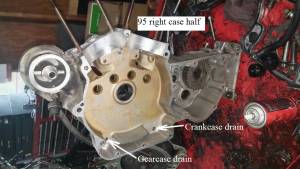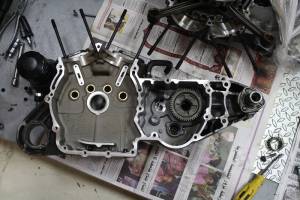This is an old revision of the document!
REF: Oiling & Lubrication - Sub-10A
Oil Pump's Role vs Wetsumping
Scavenge oil flow to the pump is accomplished by the scavenging effect of the pump and by the pressure created by the downward stroke of the piston. 1)
Scavenge pumps need some means of getting the oil to the pumps. 2)
Or, rather, having a pressure differential between the pump gears and crankcase to blow/suck the oil/air mix from the crankcase to the pump mechanism.
With too high a crankcase vacuum scavenging properly can be a problem.
For best results, sufficent airflow to carry the oil as a mist or droplets is much better than trying to pump oil alone.
As in a vacuum cleaner:
It uses the airflow to carry the dust, it cannot just suck dust alone.
Using a container of dry sand:
If you hold the tip a little above the surface, the air being sucked into the vacuum carries the sand with it.
But, if you stick the tip deep into the sand, it will cease working.
Therefore, there is both a suction created by the pump and a pushing effect created by the downward stroke of the piston.
Ideally, the oil pump's scavenge side should remove more oil then the feed side can deliver into the engine. This prevents wet sumping.
However, there are times when it does not which contributes to wet sumping.
The downward stroke helps but it is the suction from the scavenge section that does the most work.
You would have suction from the scavenge pump if the oil was up to the level of the scavenge pump inlet (in the sump). 3)
But unfortunately there's sometimes air in there, foamy oil, etc. and the pump is working against a vacuum (condition) in the crankcase.
And the pump just can't move the oil out fast enough.
Looking at the bottom of the flywheel compartment compared to the inlet of the scavenge pump;
The bottom of the crankcase is below the inlet of the scavenge pump 0n 86-03 engines.
The inlet is a closer to the bottom on 04 Up engines.
Because of that the scavenge pump doesn't remain submerged in oil all the time.
There's air (which is carried by the oil in the form of bubbles) in that passage.
And the air & oil in the entire area, including that passage, are constantly subjected to the rapidly changing pressure of the crankcase.
You could say the pump cavitates momentarily and is working against a vacuum so it has a hard time recovering.


